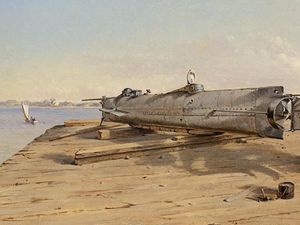The 150-year-old mystery of how the Hunley submarine crew died has been solved
The American Civil War submarine’s crew were the first ever to sink an enemy ship.

Crewmen aboard the first submarine to sink an enemy ship were killed by the pressure blast of their own torpedo, research has shown.
The 39ft vessel, HL Hunley, took part in the American Civil War on the Confederate side. Its “engine” was a hand-cranked propeller and it carried a 135 pound copper keg of gunpowder at the end of a 16ft spar.
On its first and last mission on February 17 1864, the cigar-shaped submarine sank the 1,200 ton Union warship USS Housatonic outside Charleston harbour, South Carolina.

When the boat was raised in 2000, the skeletons of its eight crewmen were found seated at their respective stations with no sign of physical injury or any evidence that they had attempted to escape.
It has taken more than 150 years for US scientists to solve the mystery of how the men met their deaths.
They were killed instantly when the force of the torpedo’s explosion sent a shock wave blast through the submarine that would have pulverised the crew members’ internal organs, especially the lungs and brain.

“You have an instant fatality that leaves no marks on the skeletal remains. Unfortunately, the soft tissues that would show us what happened have decomposed in the past hundred years.”
The Hunley’s “torpedo” was not self-propelled but carried on the end of a 16ft wooden pole that extended in front and slightly below its bow.
When the warhead was rammed into the enemy ship’s hull beneath the waterline it exploded with enormous force. But the furthest any member of the Hunley’s crew was from the blast was just 42ft.

Passing from the water to the air inside the Hunley’s hull, the speed of the shock wave fell from about 1,500 to 340 metres per second, the study showed.
This led to what Dr Lance called the “hot chocolate effect”.
She said: “When you mix these speeds together in a frothy combination like the human lungs, or hot chocolate, it combines and it ends up making the energy go slower than it would in either one.”
As a result, soft tissue damage lasted longer and was amplified. Delicate structures in the lungs would have been torn apart, causing instant death. Traumatic brain injuries are also likely to have occurred, said Dr Lance.

“Blast travels really far underwater,” she said. “If you’re practising 200 yards away, and then you triple the size of your bomb and put it 16 feet away, you have to be at least aware that there’s a possibility of injury.”





